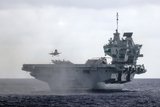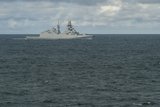Abeking & Rasmussen prepares to hand over Indonesian minehunters
Abeking & Rasmussen showed this model of the two MCMVs for the Indonesian Navy at IMDEX 2023. (Photo: Gordon Arthur)
The Indonesian Navy (TNI-AL) will receive two new 62m-long mine countermeasures vessels (MCMV) on 23 May, Shephard learned at IMDEX 2023 in Singapore.
Christoph Arndt, Sales Director of Special Vessels at Abeking & Rasmussen, noted that the two vessels, ordered under a January 2019 design-and-build contract worth $204 million, will be delivered within budget and schedule, despite the impact of COVID-19.
Steel was cut on the vessels on 26 November 2020. KRI Pulau Fani (731) and KRI Pulau Fanildo (732) were launched on 12 October 2022.
These MCMVs use hulls made from non-magnetic steel, a rare material supplied from France. However, the vessels still have to undergo degaussing because items like the engine are magnetic.
Abeking & Rasmussen also invented a unique 3D welding technique to reduce buckling in steel panels. One advantage of using non-magnetic steel throughout the ship structure is that it is more resistant to detonations than popular MCMV construction materials such as fibre-reinforced plastic.
Arndt confirmed that the two vessels constructed in Lemwerder are based on the Frankenthalclass operated by the German Navy since the 1990s, but they feature a new and slightly longer hull. Reusing design work from the German class helped reduce design costs.
An important ‘accessory’ for the pair of Indonesian MCMVs is optionally crewed Small Waterplane Area Twin Hull (SWATH) vessels. Each minesweeper will carry two of these 9m-long SWATHs that displace less than 5t. The chief advantage of the SWATH design is its stability, meaning that a 9m SWATH is as stable as a 27m monohull.
During operations, one SWATH can classify, identify, and neutralise mines. The other conducts influence sweeping by replicating electric, magnetic and acoustic signatures. Made of titanium and composite materials, it is designed to withstand mine explosions.
The MCMVs also carry a retractable multibeam echo sounder. There is a crane for lowering ROVs and AUVs, and the stern deck can cope with loads weighing up to 20t. On the stern is a launch and recovery system for the two SWATHs, plus the MCMVs accommodate two 4m RHIBs. The vessels operate with a crew of 48.
They are powered by a MAN hybrid propulsion package comprising a pair of 12V175D-MM engines producing 2,220kW at 1,900rpm; Arndt said they achieved a creditable 20kt in their sea trials.
The propulsion system also includes an AKA hybrid PTI pure electric system for silent operation whilst hunting for mines and a MAN Alpha CPP twin-screw propeller incorporating an Alphatronic 3000 propulsion control system.
Additionally, the MCMVs utilise a mine-hunting sonar, SYNTACS C2 and Synapsis NX navigation solution from Anschütz Integrated Missions Systems in Germany.
The two new vessels, which have now completed sea trials in Germany, will supplement two Dutch-built Pulau Rengat-class MCMVs and seven ex-East German Pulau Rote-class MCMVs, some of which will be retired.
Family-owned business Abeking & Rasmussen is in the final delivery phase of the project, with Indonesian crews currently receiving training on the ships in Germany.
Arndt noted that there had been renewed interest in minehunters worldwide, especially given the naval conflict in the Black Sea after Russia’s invasion of Ukraine. Governments and navies recognise how easy and impactful it would be for a bad actor to mine a strategic waterway, for example.
Related Programmes in Defence Insight
Pulau Rengat Class MCMV Replacement [Indonesia]
Related Equipment in Defence Insight
More from IMDEX Asia 2023 Show News
-
![Philippine frigates progressively advance operational capability]()
Philippine frigates progressively advance operational capability
A couple of years into their service, the Philippine Navy continues to improve and test its two South Korean-built frigates.
-
![IMDEX 2023: MBDA and PGZ partnership includes ‘deep industrial cooperation’ on CAMM-ER]()
IMDEX 2023: MBDA and PGZ partnership includes ‘deep industrial cooperation’ on CAMM-ER
MBDA has confirmed that work with Poland on land and maritime air defence includes cooperation on the extended-range version of the Common Anti-Air Modular Missile (CAMM), known as CAMM-ER.
-
![Exclusive: Royal Navy Second Sea Lord on ships, the defence command paper, and the future Indo-Pacific presence]()
Exclusive: Royal Navy Second Sea Lord on ships, the defence command paper, and the future Indo-Pacific presence
The UK Royal Navy’s Second Sea Lord VAdm Martin Connell said it shouldn’t be a surprise that adjustments must be made ahead of a hotly anticipated new Defence Command Paper and praised the progress made by HMS Tamar and Spey in reinforcing the UK’s commitment to the Indo-Pacific.
-
![IMDEX 2023: Fincantieri seeks to satisfy conditions for Indonesian FREMM frigate deal]()
IMDEX 2023: Fincantieri seeks to satisfy conditions for Indonesian FREMM frigate deal
Italian shipbuilder Fincantieri is continuing to work with Indonesia to satisfy the conditions for a FREMM frigate contract to enter into effect.
-
IMDEX 2023: Flyby and Thales look to further Jackal development after successful missile firing
Having successfully developed and successfully fired a Lightweight Multi-Role Missile (LMM) from the Jackal drone, Flyby Technology and Thales see the system as offering a cross-domain capability for the UK and others.
-
![IMDEX 2023: New Chinese-built LPD arrives in Thailand]()
IMDEX 2023: New Chinese-built LPD arrives in Thailand
A new Chinese-built LPD, HTMS Chang, arrived in Thailand in late April, having been collected by the Royal Thai Navy earlier that month.
























